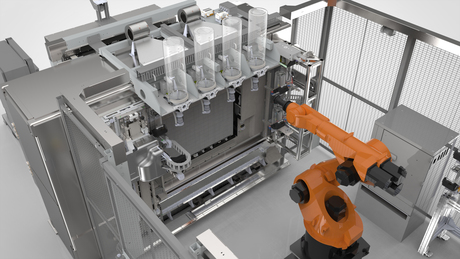Infinite-build and robotic 3D additive manufacturing demonstrated by Stratasys
Tuesday, 30 August, 2016

Stratasys has announced it is previewing demonstrations of next-generation manufacturing technologies at IMTS 2016 as part of its SHAPING WHAT’S NEXT vision for manufacturing. SHAPING WHAT’S NEXT builds on Stratasys’ industrial FDM 3D printing expertise to respond to the needs of customers’ most challenging applications, addressing manufacturers’ needs to rapidly produce strong parts ranging in size from an automobile armrest to an entire aircraft interior panel. The Stratasys ecosystem of additive and traditional technologies, software workflows, materials development and professional services aligns with individual application needs, better meeting quality, cost and delivery metrics while unlocking the capabilities of additive manufacturing to revolutionise how parts are designed and built.
The Stratasys Infinite-Build 3D Demonstrator (pictured) is designed to address the requirements of aerospace, automotive and other industries for large, lightweight thermoplastic parts with repeatable mechanical properties. The product features a new approach to FDM extrusion that increases throughput and repeatability. The system turns the traditional 3D printer concept on its side to realise an ‘infinite-build’ approach that prints on a vertical plane for practically unlimited part size in the build direction.
Aerospace company Boeing played an influential role in defining the requirements and specifications for the demonstrator. Boeing is currently using an Infinite-Build 3D Demonstrator to explore the production of low-volume, lightweight parts. Ford Motor Company is also exploring innovative automotive manufacturing applications for this demonstrator and will evaluate this new technology. Ford and Stratasys will work together to test and develop new applications for automotive-grade 3D-printed materials that were not previously possible due to limited size, enabling and accelerating innovative automotive product design.
“Additive manufacturing represents a great opportunity for Boeing and our customers, so we made a strategic decision more than a decade ago to work closely with Stratasys on this technology. We are always looking for ways to reduce the cost and weight of aircraft structures or reduce the time it takes to prototype and test new tools and products so we can provide them to customers in a more affordable and rapid manner. The Stratasys Infinite-Build 3D Demonstrator enables products to be made at a much larger and potentially unlimited length, offering us a breakthrough tool to add to our robust additive manufacturing processes,” said Darryl Davis, president, Boeing Phantom Works.
“3D printing holds the promise of changing automotive design and manufacturing because it opens up new ways to innovate and create efficiencies in production. Our vision at Ford is to make high-speed, high-quality printing of automotive-grade parts a reality. We are excited about the future opportunities that the scalable and versatile Infinite-Build concept can unlock and look forward to collaborating with Stratasys to help achieve our goals,” said Mike Whitens, director, Vehicle Enterprise Sciences, Ford Research & Advanced Engineering.
Stratasys and Siemens have also been working very closely together to further their shared vision of making 3D printing a viable and indispensable component of production manufacturing. As an example of this vision, Stratasys developed the Robotic Composite 3D Demonstrator, integrating its core additive manufacturing technologies with industrial motion control hardware and 3D-printing software capabilities provided by Siemens. This Robotic Composite 3D Demonstrator is designed to revolutionise the 3D printing of composite parts.
In addition to widespread use in transportation industries like automotive and aerospace, industries such as oil and gas and medical use composite materials to make strong yet lightweight structures. Unfortunately, composites production is constrained by labour-intensive processes and geometric limitations. The Robotic Composite 3D Demonstrator delivers true 3D printing by using an 8-axis motion system that enables precise, directional material placement for strength while also reducing the need for speed-hindering support strategies. This redefines how future lightweight parts will be built and provides a glimpse into how this technology could be used to accelerate the production of parts made from a wide variety of materials.
“Siemens is pleased to support Stratasys in their innovative additive manufacturing initiatives, of which the Stratasys Robotic Composite 3D Demonstrator is one of the most promising. By working closely with Stratasys on motion control and CNC automation, Siemens is helping to create a flexible, multifunction manufacturing workflow that puts 3D printing firmly in the factory. We look forward to continuing to work with Stratasys to build manufacturing solutions that transform industries,” said Arun Jain, VP, Motion Control, Digital Factory US, Siemens.
“Stratasys is building on our success in manufacturing with applications such as manufacturing aids, injection moulds and composite tooling, and leveraging our relationships with innovative industry leaders to further extend the applicability of additive manufacturing in demanding production environments,” said Ilan Levin, CEO, Stratasys. “We view the level of factory integration, automation and performance monitoring potentially offered by these new demonstrators as catalysts for the transformation to Industry 4.0.”
China to invest 1 trillion yuan in robotics and high-tech industries
China's National People's Congress has announced a venture capital fund to expand...
Schneider Electric signs Motion Solutions as ANZ cobot distributor
Motion Solutions Australia and Motion Solutions New Zealand have been appointed as Schneider...
Top 5 robotics trends for 2025
The International Federation of Robotics has identified five key trends in robotics for 2025.








